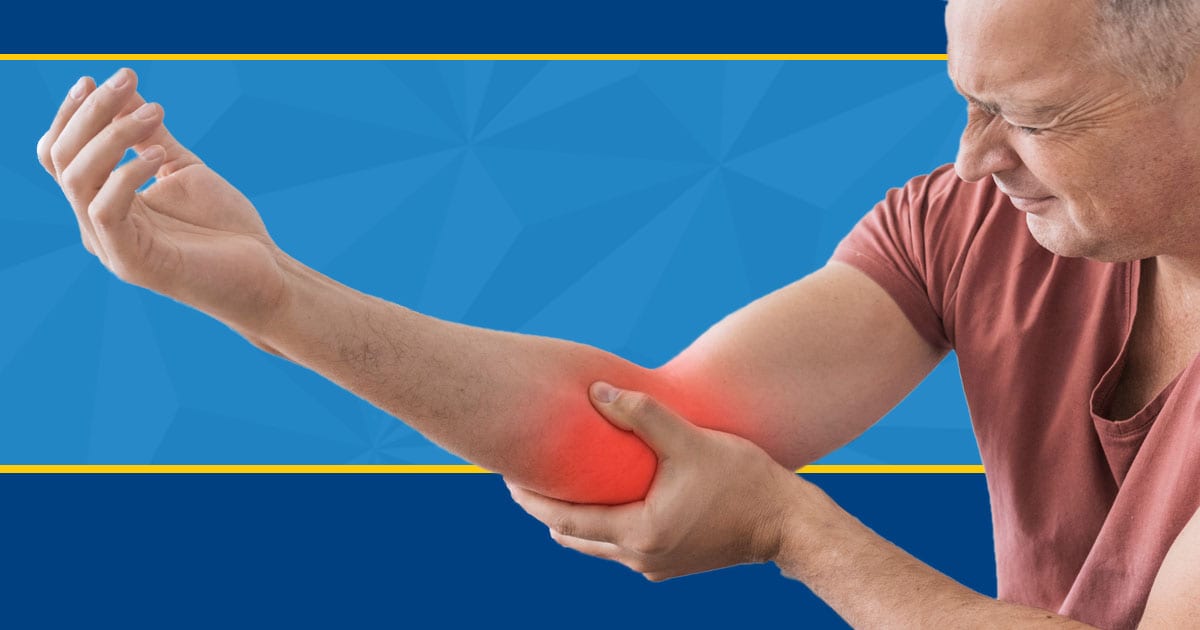
If you’ve ever hit your funny bone on a hard corner, you know how painful and sensitive it can be. The funny bone is actually your ulnar nerve. The ulnar nerve sits in a groove (the cubital tunnel) on the inside of the elbow.
Cubital tunnel syndrome, also known as ulnar nerve entrapment, is when the ulnar nerve becomes compressed as it wraps around the elbow. This compression can cause numbness, (particularly in the ring and small fingers), elbow pain, and ultimately weakness of the hand and arm.
In today’s post, elbow specialist Brandon P. Donnelly, MD explains this painful condition and the latest treatment options.
Anatomy of the cubital tunnel

The ulnar nerve travels from your neck, along your arm, and into your hand. There are a few spots along this pathway where the nerve can become compressed.
The two most common areas of compression are at Osborne’s fascia, which is a thick ligament that forms the roof of the carpal tunnel and the opening between the two heads of a muscle (flexor carpi ulnairs), just down from the elbow.
This “cubital tunnel” encompasses the course of the ulnar nerve that runs from just above to just below the bony bump on the inside of the elbow elbow (the medial epicondyle).
What is cubital tunnel syndrome?
Although you don’t hear about it often, cubital tunnel syndrome is actually the second most common peripheral nerve entrapment syndrome in our bodies. Much like carpal tunnel syndrome, cubital tunnel syndrome occurs when the ulnar nerve becomes stretched, pinched or otherwise irritated within the cubital tunnel.
Symptoms of cubital tunnel syndrome
The main symptom of cubital tunnel syndrome is that your elbow really hurts. However, you might be surprised to know that many symptoms of this elbow disorder manifest in your hand.
Here are some of the other symptoms:
Numbness
You might feel numbness in your ring and pinkie finger. This feeling might not be constant and more often occurs when your elbow is bent in the same position for a while--like talking on the phone, reading in bed, or sleeping.
Pins and needles
When you bend your elbow, it may feel as if your fingers are asleep—especially your ring and pinkie fingers. This pins and needles feeling is caused by the pinched ulnar nerve.
Hand Weakness
If your cubital tunnel syndrome is severe enough, your grip will become weaker and it may be hard to perform simple tasks such as opening a jar or buttoning buttons.This happens because the compressed nerve can no longer send the appropriate signals to the muscles of the hand.
"People who are at risk of getting cubital tunnel syndrome are those who hold their elbows bent for extended periods of time."Brandon P. Donnelly, MD
Who gets cubital tunnel syndrome?
People who are at risk of getting cubital tunnel syndrome are those who hold their elbows bent for extended periods (for example, people who are on the phone for long periods of time). If you have other musculoskeletal disorders like golfer’s elbow or carpal tunnel syndrome, you may also be at increased risk. Additionally, you might be at risk if you have bone spurs or arthritis in your elbow, a previous fracture, or cysts close to your elbow joint.
What causes it?
There are several causes for cubital tunnel syndrome, and they all involve compression of the ulnar nerve.
Here are some specific causes:
Sliding or stretching of the nerve
When you bend your elbow for long periods of time, the ulnar nerve can shift out of place or snap over the medial epicondyle - the bony point on the inside of the elbow. Over time, this grating action can irritate the nerve.
Pressure
If you lean on your elbow a lot, like long distance drivers who rest their elbow on an unpadded vehicle door, this puts added pressure directly on the nerve and can aggravate it.
Hitting the elbow
A blow to the elbow, commonly referred to as "hitting your funny bone," can cause that familiar electric shock-like sensation and numbness in the little and ring fingers. This is usually temporary. However, significant or repetitive trauma to the elbow can damage the ulnar nerve.
Treatment options
One thing any orthopedic hand specialist will recommend is to avoid activities where your elbow is bent for prolonged periods. There are also nonsurgical and surgical treatment options for cubital tunnel syndrome:
Nonsurgical Options
Anti-inflammatory medicine
Reducing swelling around the nerve will also reduce the pressure on it. An anti-inflammatory medication like ibuprofen may be used to counteract inflammation.
Bracing
A brace or splint will control the movement of your arm and take pressure off of the nerve. This can be especially helpful at night to keep your arm in a straight position.
Physical therapy
Physical therapy is often recommended to increase range of motion and strengthen the muscles in the arm and hand. Nerve gliding exercises can help the nerve more easily slide through the tunnel. Cubital Tunnel Syndrome Exercises to Relieve Pain
Surgical Options
If the nonsurgical options aren’t giving you relief from your symptoms, you may require surgery. There are a couple of options:
Open In Situ cubital tunnel release
In this procedure, the surgeon expands the tunnel by making an incision and releasing the tissues that sit on top of the ulnar nerve, causing compression. In this way, the nerve has more room in the tunnel. This surgery is most often recommended for mild or moderate cases of cubital tunnel syndrome.
Endoscopic cubital tunnel release
Endoscopic cubital tunnel release surgery also expands the tunnel. This minimally invasive procedure is performed using an endoscope, which helps the surgeon visualize the nerve through a small incision. A smaller incision means less post-surgical pain, a smaller scar, and a faster return to normal range of motion and daily activities.
Ulnar nerve anterior transposition
Here, the ulnar nerve is moved so that it doesn’t stretch out over the bony ridge. In this procedure, the course of the ulnar nerve is released like a standard release. Then, it is moved or transposed to the front of the elbow into a more protected position.
Medial epicondylectomy
In this procedure, the surgeon releases the pressure on the nerve by taking out a part of the medial epicondyle. By doing this, the nerve is less likely to stretch or get caught along the bony prominence.
There’s nothing funny about chronic pain in your elbow or numbness and tingling in your fingers. You may have cubital tunnel syndrome. Contact us today to schedule a consultation with hand, wrist, and elbow specialist, Brandon P. Donnelly, MD.
About Dr. Brandon P. Donnelly, MD
 Dr. Brandon P. Donnelly is a board certified orthopedic surgeon with Pontchartrain Orthopedics & Sports Medicine. Dr. Donnelly completed his hand and microsurgery fellowship at the prestigious Philadelphia Hand to Shoulder Center. Dr. Donnelly treats all ages of patients in the greater New Orleans area for hand, wrist, and elbow conditions.
Dr. Brandon P. Donnelly is a board certified orthopedic surgeon with Pontchartrain Orthopedics & Sports Medicine. Dr. Donnelly completed his hand and microsurgery fellowship at the prestigious Philadelphia Hand to Shoulder Center. Dr. Donnelly treats all ages of patients in the greater New Orleans area for hand, wrist, and elbow conditions.
This site is not intended to and does not provide medical advice, professional diagnosis, opinion, treatment or services to you or to any other individual. Through this website and links to other websites, Brandon P. Donnelly, MD provides general information for educational purposes only. The content provided in this website and links, is not a substitute for medical care or treatment. You should not use this information in place of a consultation or the advice of your healthcare provider. Brandon P. Donnelly, MD is not liable or responsible for any advice, course of treatment, diagnosis or any other information, services or product you obtain through this site.

